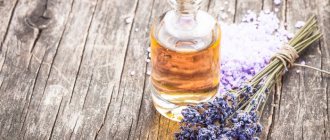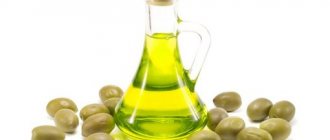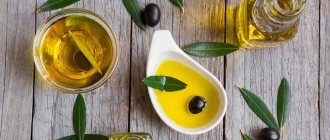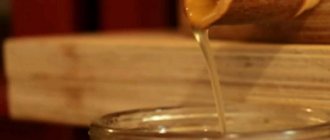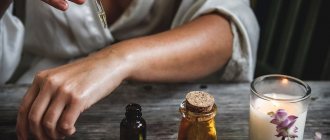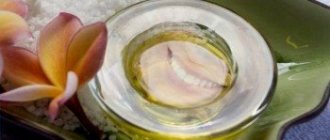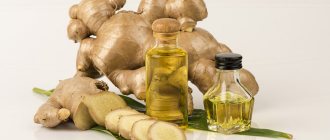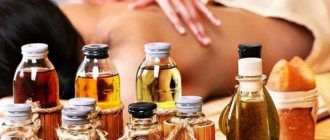Benefits of oils
Why oil, you ask. You can use your usual cream according to your skin type, and not waste time preparing homemade masks. You are right about this.
However, you will have to pay a lot of money for high-quality cosmetics, while oils cost pennies. Any cream works only in the superficial layers of the skin, but a natural product penetrates into deep structures and works at the cellular level.
Cosmetics give a positive effect while you use them, and oils have a long-lasting effect.
In addition, the likelihood of developing an allergy is possible only if there is an individual intolerance to natural components. While the cream includes many chemical additives, the skin reaction is quite difficult to predict.
Although to be fair, if you decide to use oil instead of cream, don't expect quick results. You will be able to enjoy the beauty of your skin only after 2-3 weeks of regular procedures.
Rating of the best ointments for wound healing, applicable in the first stage of treatment
Regenerating agents are selected taking into account the degree of tissue damage and the type of wound.
There are wound-healing ointments for treating superficial wounds - shallow cuts, abrasions and scratches. And means for solving more dangerous problems - burns, trophic wounds, festering abscesses. Any wound, regardless of origin, has two stages of development and healing: inflammatory and restorative. At the first stage, the wound bleeds and becomes inflamed, the damaged tissues die, and during this process ichor and pus can be released. At the first stage, an antiseptic healing ointment should be used.
- Relieves inflammation.
- Disinfect.
- Easy to apply.
- Can be used without consulting a doctor.
- Sold in pharmacies without a prescription.
Minuses
- They have contraindications and side effects.
- There is a risk of allergic reactions.
- These remedies are not equally suitable for everyone.
- Some people may be intolerant to the components included in the ointments.
https://www.youtube.com/watch?v=ytpressru
Healing wounds of any origin begins with their disinfection. For this purpose, antiseptic and antibacterial agents are used. First, the wound must be treated with a solution of iodine, green diamond or hydrogen peroxide. Then one of the following products is applied to the weeping abrasion.
| Rating | #1 | #2 | #3 |
| Name | Levomekol | Streptoplaven | Nitacid |
Rescuer
An effective drug with analgesic, antiseptic, anti-inflammatory and healing effects. Effective for scratches, abrasions, cuts and bruises.
pros
- Made from plant ingredients.
- It has virtually no contraindications or side effects.
- The effect is noticeable immediately after application.
- Treats diaper rash, dermatitis, acne, burns, frostbite, cracked nipples during breastfeeding.
- Suitable for children's first aid kit.
- Affordable price.
Minuses
- Not the best remedy for healing complex, festering wounds.
- Sometimes plant components provoke allergic reactions.
Streptoplaven
Wound healing occurs through the melting of dead cells and their rejection. Primarily used in the treatment of trophic ulcers and deep burns.
pros
- Contains miromistin, which additionally disinfects wounds.
- The drug is made on a water basis, thanks to which the active components easily penetrate into the deep layers.
- Helps fight gangrene, which is a consequence of diabetes or atherosclerosis.
Minuses
- To achieve a good effect, you need to use a large amount of ointment.
- Active components may cause allergic reactions.
Nitacid
An effective remedy for treating suppurating wounds. Contains streptocide and netazol, the combination of these two substances provides an effective effect on almost all types of bacteria.
pros
- Widely used for disinfection of postoperative sutures, treatment of abscesses and purulent wounds.
- Effective for wounds of thermal origin of varying degrees of severity.
- For purulent injuries, it is enough to place a tampon soaked in this product on the wound once a day.
- For burns, the damage is treated with the product at least twice a week.
Minuses
- As a powerful antibacterial agent, it has a number of contraindications.
- Not tolerated equally well by all patients.
A powerful anti-infective agent with universal action. Immediately after injury, it quickly relieves swelling, helps stop bleeding, and reduces pain.
Subsequently, it disinfects the surface of the wound, destroys pathogenic microflora and effectively cleans the wound before applying other drugs.
pros
- It treats not only abrasions, cuts, burns and frostbite, but also bedsores, weeping eczema, ulcers, and herpes.
- Effective against fungal infections.
- Allowed for pregnant and lactating women.
- Available in the form of a solution, ointment and napkins soaked in a solution of the drug.
Minuses
- Do not apply to open bleeding wounds, as Eplan affects blood clotting.
Levomekol
The active component of this drug is chloramphenicol; most microbes are sensitive to this substance. It also contains methyluracil, which has the unique property of increasing the natural immunity of cells.
The ointment is spread in a thin layer on the cleaned surface of the wound, and a sterile bandage is applied on top. The procedure is performed up to four times a day until the wound begins to heal.
pros
- The drug has a wide spectrum of action - the ointment can be used to disinfect both small cuts and abrasions, as well as poorly healing purulent wounds, weeping ulcers, and thermal injuries.
- Used for rapid fusion of postoperative sutures.
- Available without a prescription and inexpensive.
Minuses
- Contains antibiotics, therefore it has a number of contraindications.
- Not the most convenient method of application - the wound must be constantly cleaned and disinfected, and only after that apply the product, and then apply a bandage
- Some patients have individual intolerance to the active components of this ointment.
Each stage has its own optimal means. You should not prematurely use a healing cream that promotes the formation of new tissues - pus may remain under the young thin skin, it will accumulate and ultimately lead to serious complications, including opening the abscess and cleaning the wound surgically.
- Effectively dry and restore damaged tissues.
- Can be used to heal various wounds, including burns and frostbite.
- Penetrate deep into the layers of the skin and restore cells.
- Prevents the inflammatory process.
We invite you to familiarize yourself with Salted herring: the experts' choice
Minuses
- The need to pre-treat the wound with antiseptic and disinfectants.
- Some ointments have side effects.
- People with individual intolerance to the components of the drug may experience allergic reactions.
When dead tissue has already been removed, purulent discharge is insignificant, wound healing moves to the next stage. New, healthy tissue begins to form, and the wound becomes scarred. To speed up this process and prevent scars, various regenerating agents are used.
| Rating | #1 | #2 | #3 |
| Name | Actovegin | D-panthenol | Bepanten |
Baneocin
https://www.youtube.com/watch?v=ytpolicyandsafetyru
Another universal antiseptic and wound healing agent. In powder form it can be used immediately after injury.
For tissue regeneration and rapid scarring, it is preferable to use a cream.
pros
- Contains lanolin, which prevents drying out and cracking of the drying wound.
- Forms a protective film, preventing infection from re-entering the wound.
- It is used in pediatrics to treat the umbilical wound in newborns.
Minuses
- Not the most affordable remedy; you can’t find it in every pharmacy.
- It is quite expensive compared to other drugs.
Solcoseryl
This product is made from an extract of calf blood serum, deprived of natural protein through special processing. Active components quickly penetrate deep into tissues, accelerate metabolic processes at the cellular level and thereby help to quickly restore damaged skin.
pros
- Effectively saturates cells with oxygen and nutrients.
- Accelerates metabolic processes.
- Forms a protective fatty film on the surface of the wound, which prevents re-infection.
- Relatively low price.
Minuses
- The effect of the drug has been little studied.
- Despite the fact that the drug is based on natural raw materials, intolerance to this drug is often noted.
- The ointment can be applied only after the surface of the wound has been disinfected. Otherwise, tissue suppuration may occur.
Actovegin
A broad-spectrum drug available in various pharmaceutical forms - as tablets, injection solution, ointment for external use. Wound healing ointment acts in two directions at once: it destroys bacteria and improves tissue regeneration.
pros
- Can be used at any stage of healing of scratches, abrasions, cuts and burns.
- Helps even with severe, long-term non-healing skin lesions, bedsores, and trophic ulcers.
- Economical to use.
Minuses
- The effect of the drug has not been fully studied; it is banned in some European countries.
- Has side effects.
Bepanten
This product also affects metabolic processes in skin cells and stimulates its regeneration. The active component is dexpanthenol.
pros
- It quickly penetrates deep into tissues, is converted into pantothenic acid and interacts with epithelial cells.
- Prevents the development of the inflammatory process.
- Effective in the treatment of burns of various origins.
- Can be used for preventive purposes as a diaper cream in the care of newborns.
- Strengthens local immunity.
Minuses
- In case of individual intolerance to the components of the drug, it causes allergic reactions.
D-panthenol
The active ingredients of this ointment activate collagen production and regulate metabolic processes at the cellular level. Dexpanthenol, the main active component of the product, contains pantothenic acid, without which the formation of epithelial cells is impossible.
pros
- Indicated for the treatment and prevention of diaper rash in infants.
- Helps with burns and frostbite.
- Heals cracked nipples in women.
Minuses
- It has only a slight antiseptic and anti-inflammatory effect, so the wound must be disinfected before distributing the ointment.
- To obtain a good effect, the ointment should be applied many times, after first cleaning and disinfecting the damaged areas of the skin.
Jojoba oil
The beneficial properties of jojoba oil are determined by its composition. Vitamin E stops the aging process, accelerates cell regeneration, and smoothes the microrelief. It has a lifting effect, restores lost elasticity, and protects against the negative effects of free radicals.
Other beneficial substances create a protective film on the skin, thereby preventing moisture loss and preventing the appearance of flaking. They give the product softening, moisturizing, nourishing and anti-inflammatory properties.
The oil can be used for any type of skin. It solves especially well the problems of sensitive, dry and aging skin.
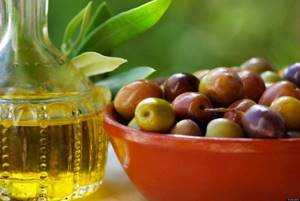
Jojoba oil
I want to share with you several recipes for simple but effective procedures. In order not to repeat myself, I will say right away: the duration of action of any mask described in the article is 20 minutes, the frequency of use is once every 3 days, unless other recommendations are indicated.
- For deep wrinkles. Mix jojoba oil and avocado oil in equal quantities, spread the mixture over your face, and leave for 20 minutes. A rejuvenation session must be carried out every day. For prevention – 1 time every 3 days, before bedtime;
- For nutrition and deep hydration. Combine jojoba and grape seed oil in a 1:1 ratio, add a drop of orange ether;
- For inflammation and acne. Add 2 drops of lavender and clove ether to 15 milliliters of base.

Jojoba oil for face
Lavender oil for scars and scars
Even scars and stretch marks succumb to lavender oil. Although it cannot be said that cosmetic defects disappear without a trace, especially if the problem is long-standing. The older and larger the scar, the more difficult it is to get rid of it, and vice versa.
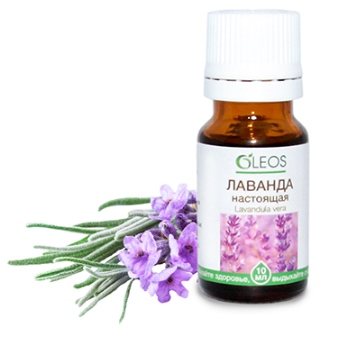
A mixture of rosemary (2 drops), lavender (2 drops), clove (1 drop), mint (1 drop) and a teaspoon of base oil (almond, peach, grape seeds, etc.). The aromatic mixture should be rubbed into the scar area 2-3 times a day.
Applications with clay are also effective for scars on the face.
. Take:
- 1 tablespoon blue, white or green clay
- 1 half spoon of water
- 2 drops lavender oil
- 4 drops rosemary oil
- 2 drops of lemon oil.
Mix everything and apply to the problem area. After 10-15 minutes, rinse with water. Remember to repeat the “procedure” several times a week. A good remedy for scars can be obtained by combining the essential oils of lavender and myrrh.
. In a “duet”, their powerful regenerating and smoothing properties will give maximum results. Dissolve 2 drops of each “essential” in a teaspoon of any base oil. Rub into the problem area twice a day.
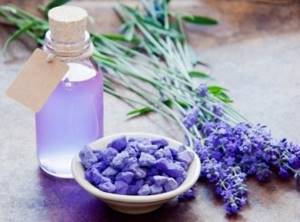
Wheat germ oil
Wheat germ oil is very beneficial for the face. It stimulates metabolic processes in cells and promotes their renewal, protects against photoaging, evens out microrelief and normalizes facial tone. The active components of the product strengthen capillaries, prevent the appearance of rosacea, remove toxic substances and excess fluid.
The product has softening, moisturizing, nourishing, whitening and anti-inflammatory properties. Effectively copes with pigmentation, rashes, irritation, pimples, eliminates dark circles under the eyes, tightens the oval of the face in women after 50 years.
Below I have collected simple recipes for use:
- acne: 15 milliliters of base, 2 drops each of lavender, cedar and clove ether;
- age spots: 15 milliliters of base, 1 drop each of lemon, bergamot and juniper ether. Use the product morning and evening, daily;
- against wrinkles and sagging: 15 milliliters of base, 1 drop each of mint, orange and sandalwood ester.
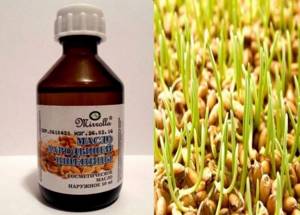
Wheat germ oil
Rose ether
Rose ether increases the production of natural collagen and elastin, smoothes wrinkles, tightens the oval of the face, and is effective against jowls and double chins.
It is able to get rid of spider veins and spider veins, stops inflammatory processes, eliminates pimples, acne, pigment spots, and relieves fatigue.
Rose oil is characterized by wound-healing, softening, antioxidant, antitoxic, anti-inflammatory and rejuvenating properties. Perfectly relieves puffiness of the eyelids and eliminates dark circles under the eyes.
You can use the tool like this:
- from the double chin: combine 50 milliliters of almond oil, 10 milliliters of wheat germ oil, 5 drops of rose essential oil;
- herpes on the lips: lubricate the affected area with ether, 3-4 times a day;
- for acne: dilute 15 grams of yellow clay with nettle decoction to a creamy consistency. Add 5 drops of rose ether and turmeric on the tip of a knife: rinse with water and lime juice.
A nice bonus is that the ether can be used for massage. Its vapors help you relax, relieve stress and fatigue. Such procedures also help women with frigidity, and men are cured of impotence.
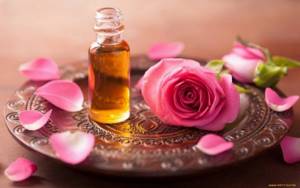
Rose ether
Use of the product for skin lesions in an adult or child
From burns (boiling water, steam, etc.)
Before using the oil, it is recommended to sterilize it using a water bath. The burn site must be prepared for treatment: take care to cool the damaged area, and then, when the pain subsides a little, lubricate it with sea buckthorn oil, removing hair from the skin (if necessary). The product should not be used immediately after a burn.
It is forbidden to open blisters that appear after a burn yourself. This procedure must be performed by specialists in a sterile hospital environment.
- In case of a burn with boiling water, it is necessary to soak a sterile gauze napkin with oil, roll it into one layer and place it on the affected area of the skin. For a second-degree burn, such an application is applied only after the blisters have been opened. The bandage is secured with a bandage, and such a compress is used for 8–10 days during a normal recovery process.
- In case of a steam burn, you should blot the area with oil every few minutes until the skin stops absorbing it. Carry out the procedure every 2 hours, increasing the period of time between lubrication. With this therapy, recovery occurs quite quickly, and the burn disappears in a couple of days.
- Shallow open burns are treated by irrigating with sea buckthorn oil. It is recommended to carry out the procedure as the product is absorbed, then 2 times a day for a week.
For wound healing
For wounds in which there is no pus, dressings can be made with sea buckthorn oil. A gauze bandage soaked in the product is applied to the affected area and secured with a bandage. Keep it on until the oil is absorbed. Repeat the procedure daily until complete healing.
Against cracks of various etiologies
Microenemas made from chamomile decoction with the addition of sea buckthorn oil help with cracks in the anus
- Cracked nipples may appear during breastfeeding. In this case, it is necessary to moisten a sterile napkin in sea buckthorn oil and apply it to the breast in the intervals between feedings of the child and at night, fixing it with a bandage or bandage until complete healing.
- Anal fissures are treated with microenemas with chamomile infusion and sea buckthorn oil. The ingredients are mixed in equal proportions and 50-60 ml of the composition is taken into a syringe, after which it is injected into the rectum (the procedure should be done in the evenings). You need to keep the product inside for as long as possible. The course of treatment lasts 2 weeks. You can also lubricate the cracks with sea buckthorn oil 2-3 times a day until complete recovery.
- If cracks appear on your hands and fingers, you should first hold your palms in a warm bath and dry them, and then rub heated sea buckthorn oil into the problem areas and put on cotton gloves. The procedure should be carried out overnight until the cracks heal.
- You can get rid of cracked heels with a compress of sea buckthorn oil. Before going to bed, you will need to apply gauze soaked in the product to your heels, securing it with plastic wrap. You should wear warm socks on top. By morning, the cracks usually heal.
- Sea buckthorn oil also helps with cracked lips. To get rid of them, you need to take a piece of cotton wool, apply a little oil on it and lubricate your lips. Repeat the procedure 3-4 times a day.
For scars, scars, acne spots
- Scars can be removed using a compress: you will need to generously apply oil to the problem area and apply a bandage of gauze or bandage. This application must be done every day at night until the damage completely disappears.
- How to get rid of acne spots: If the skin is oily, then sea buckthorn oil should be slightly warmed and used for application. After a few days, the result will already be noticeable. For dry skin, mix a teaspoon of oil with the same amount of distilled water, shake the mixture and lubricate the stain with it. After a few minutes, complete the procedure with a light massage. Continue the course of treatment until the acne marks disappear.
Against calluses
- Calluses can be painlessly reduced by treating with sea buckthorn oil. Before the procedure, you need to steam your feet for 10 minutes, then rinse them with cool water and apply a compress of gauze soaked in oil, leaving it overnight. Repeat therapy until calluses heal.
- If the callus has opened, then not only sea buckthorn oil will be useful, but also its juice for disinfection. First you need to squeeze the juice from 50 g of berries and lubricate the problem area with it, and then apply a gauze compress with oil overnight. If the callus does not heal the next day, you will need to repeat the procedure.
The oil can be used to apply diaper rash that appears on the baby's skin. Burns on children are treated with the product in the same way as on adults. It is also not forbidden to apply compresses with sea buckthorn oil to children if the child often falls and gets injured.
Video: How to make sea buckthorn oil yourself?
Avocado oil
With regular use, it improves blood circulation, ensures sufficient nutrition of cells and tissues with nutritional components, as well as oxygen, and removes toxic compounds.
Avocado oil is able to penetrate into the deep structures of the skin, stimulating the production of its own collagen and elastin. Accelerates tissue regeneration abilities, eliminates dryness, peeling, irritation and inflammation.
Below are simple recipes for using the oil:
for aging skin: 15 milliliters of base, 2 drops each of sandalwood, chamomile, orange and rose essential oils;
- for dry skin: dilute 15 grams of green clay with a small amount of water. Add 5 grams of honey, 5 drops each of avocado and coconut oil. Keep the mask on your face until completely dry. Repeat the intensive moisturizing procedure every other day;
- to improve skin tone: 15 milliliters of sour cream, 5 milliliters of avocado oil, 4 drops of freshly squeezed lemon juice;
- rejuvenation: mix avocado and olive oil in a 1:1 ratio. Wash off after 15 minutes.
The product can be used independently to care for the delicate skin around the eyes. It restores the necessary level of moisture, smoothes facial wrinkles, and stimulates the barrier functions of local immunity. Gently protects from the negative effects of ultraviolet radiation, wind and low temperatures.
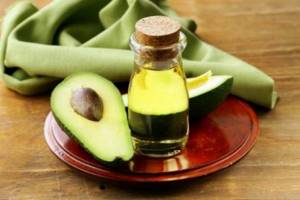
Avocado oil
Olive oil
The product is suitable for the care of dry, problematic and sensitive skin. Olive oil
- accelerates blood circulation,
- regulates cell renewal,
- evens out the microrelief and
- slows down the natural aging process.
It neutralizes the negative effects of free radicals and protects against the negative effects of direct sunlight and cold air.
The product has a moisturizing, softening, nourishing, regenerating, bactericidal and soothing effect.
Most often, the oil is used as an independent remedy, applying it to the face and lightly patting it with your fingertips.
Peach oil
The product of cold pressing of peach pits frees the skin from toxic compounds, gently removes dead cells, normalizes the functions of the sebaceous glands, and eliminates rashes.
Peach oil improves blood circulation and complexion, promotes rapid healing of skin lesions, and eliminates peeling. Long-term use helps reduce the number and depth of wrinkles, restore the necessary level of moisture in cells, normalize melanin production, and cleanse the face of pimples and blackheads.
The base oil has a softening, antioxidant, moisturizing, tonic, regenerating and soothing effect.
How to use peach product? Check out several effective recipes:
- for rashes: 15 milliliters of chamomile decoction, 5 drops each of peach and tea tree oil. Apply the resulting solution with a cotton swab to problem areas. Do not rinse;
- for pigment spots: combine an equal amount of base with lemon, grapefruit or orange essential oil. Apply to areas that need lightening. Wash off after 3 hours;
- for tired skin: dampen a clean cloth with hot water and squeeze out excess moisture. Soak the cloth with 20 drops of peach oil and place the application on a cleansed face. Remove after a third of an hour.
If your foundation combines well with fatty acids, peach oil can be used as a makeup base. Throughout the day, it will protect the skin from pollution and chemicals of the decorative product, moisturizes and saturates with useful components.
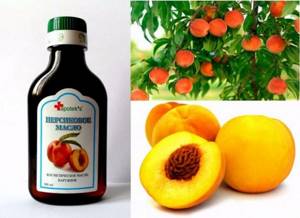
Peach oil
Treating scars with essential oils
So, to eliminate scars, try using oil mixtures: mint essential oil with neroli and rosemary oil (literally a drop of each); frankincense oil with rose and tea tree oils; geranium oil with hyssop and fennel oil. Apply the mixture to the affected area for a few minutes. Carry out the procedure twice a day.
A fairly effective remedy for removing scars is camphor oil. Soak a linen napkin in the product and apply to the problem area.
Cover the top with cellophane and secure with adhesive tape. Go to bed with this compress. Carry out this treatment every day.
Properties of tea tree
Tea tree essential oil is obtained by steam distillation from the leaves of the Melaleuca alternifolia plant. It is native to Australia, where the leaves have long been used to make tea, hence the name tea tree oil.
Although research on the benefits of tea tree oil is limited, it has been found to be particularly helpful in relieving skin problems such as scars, abrasions, keloids and acne.
In any case, you should consult your doctor before using tea tree oil, especially if you have any skin allergies.
How to use tea tree oil for keloid scars?
Tea tree essential oil is very helpful in getting rid of hypertrophic and keloid scars.
Moreover, some people use it to inhibit the growth of keloid scars, as well as to relieve the inflammation and itching associated with them.
You can use tea tree oil directly on the site of the keloid or healing skin, or mix the oil with vitamin E and use a sponge to blot the keloid.
For those who are prone to breakouts and allergies due to essential oils: add a few drops of tea tree oil to a hot water solution.
Using tea tree oil at home:
- To prepare the solution, take a cup of warm water.
- Add half a teaspoon of sea salt and a few drops of tea tree essential oil.
- Soak the area with the keloid scar in water for 15 minutes.
- Treatment is repeated twice daily for at least 15 days.
You can use tea tree oil on keloids that are caused by ear piercings.
Apply tea tree oil using a cotton swab around the punctured hole and leave it on for a while before rinsing off with warm water. Repeat the procedure 4 to 5 times a week.
Avoid using tea tree oil on non-healing piercings and mucous membranes such as the mouth, genitals, eyes and nostrils.
St. John's wort oil
If the scars, in addition to discomfort, also cause pain, use the following remedy. Fill a liter bottle with fresh chopped St. John's wort herb. Then fill the raw material with purified vegetable oil.
Close the container tightly and refrigerate for 15 days. After the time has passed, strain the composition and pour into a bottle convenient for storage.
In the resulting mixture, moisten gauze folded in several layers and apply to the affected area for half an hour. Carry out the procedure daily until the condition improves.
Beneficial properties of sea buckthorn oil
Sea buckthorn oil is known for its regenerating qualities, allowing the skin and mucous membranes to heal in a short time.
Therefore, it is actively used for burns, wounds, ulcers, various diseases and damage to the skin, as well as to get rid of the consequences of these ailments - scars, scars, spots.
Sea buckthorn oil has the following effects:
- anti-inflammatory;
- pain reliever;
- antibacterial;
- wound healing;
- emollient;
- tonic;
- nutritious;
- moisturizing;
- protective.
Skin restoration is ensured by sterols - natural compounds that are found in large quantities in oil.
They promote accelerated cell regeneration. Vitamins A and E moisturize and nourish the skin, which also ensures its speedy recovery
Scars can be removed using a compress: you will need to generously apply oil to the problem area and apply a bandage of gauze or bandage.
This application must be done every day at night until the damage completely disappears.
How to get rid of acne spots: If the skin is oily, then sea buckthorn oil should be slightly warmed and used for application.
After a few days, the result will already be noticeable. For dry skin, mix a teaspoon of oil with the same amount of distilled water, shake the mixture and lubricate the stain with it.
After a few minutes, complete the procedure with a light massage. Continue the course of treatment until the acne marks disappear.
Apricot oil
The extract removes age spots and wrinkles, accelerates cell regeneration, tightens facial contours, and eliminates sagging. Apricot oil eliminates roughness, increases softness, removes toxic compounds, and promotes intensive production of your own collagen and elastin.
The product cleanses the face of pimples, blackheads, acne, comedones and redness, restores the normal complexion, and prevents premature fading of the skin. It regulates the secretion of sebaceous secretions, moisturizes, tones and replenishes the deficiency of nutrients.
The following recipes can be used at home:
- for problem skin. Add 2 drops of lemon, lavender or tea tree ether to 15 milliliters of warm base. Wipe areas with inflammation every day;
- from wrinkles around the eyes. Dissolve 2 drops of rose or sandalwood ester in 15 milliliters of apricot extract. Apply to the eyelid area, rinse after 20 minutes;
- for oily skin . To 15 milliliters of base add 30 milliliters of freshly squeezed lemon juice and 10 milliliters of warm honey. In addition to the fact that the mask restores the proper functioning of the sebaceous glands, it whitens the skin.
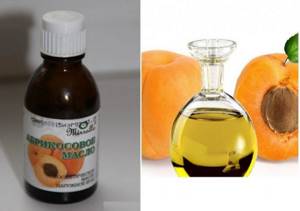
Apricot oil
Tea tree essential oil
Tea tree oil reduces the production of secretions by the sebaceous glands, destroys pathogenic microorganisms, heals the skin and stops the natural aging process. The ether normalizes the complexion, eliminating gray and yellowish tones, vascular networks, freckles and age spots, accelerates the healing of microdamages, and evens out the microrelief.
The product has antiseptic, bactericidal, antiviral, antifungal and antioxidant properties. It treats pustular acne well.
Below are the most popular uses:
- for acne: squeeze 5 milliliters of juice from an aloe leaf, add 2 drops of ether. Wipe your face daily, before going to bed;
- to mattify the skin: add 30 milliliters of sour cream and 2 drops of ether to 5 grams of white clay. Keep the mask on for 15 minutes;
- against wrinkles: dilute 5 grams of red clay with a small amount of water, add 3 drops of the product. Using tea tree ether helps not only get rid of existing acne, but also prevent its reappearance.
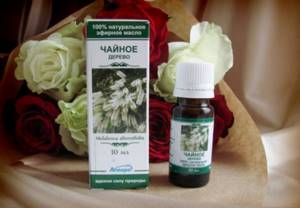
Tea tree oil
Healing properties of tea tree oil
Nowadays, essential oil is widely used and has various shades from whitish to pale yellow. A little less commonly used is an extract (extract from the leaves), which is added to medicines and cosmetics.
Regular stores sell a “cosmetic” product containing a minimum (10–15%) of oil. The basis for it is purified oil of other types (sea buckthorn, olive, etc.). For treatment, you need a pure, undiluted product, which can be found in specialized incense stores or pharmacies. Before purchasing, experts recommend carefully studying the composition on the label.
The product has a variety of effects:
- bactericidal;
- antivirus;
- immunoprotective;
- antiseptic (much stronger than phenol).
- anti-inflammatory;
- antifungal;
It is used:
- externally, as an independent drug;
- in combination with other components (oils, water, herbal decoctions);
- add a few drops to herbal decoctions for inhalation.
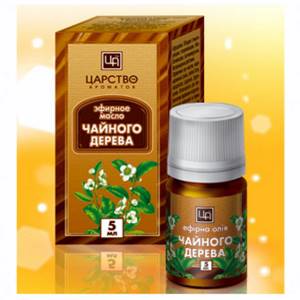
The product is not taken orally (orally) in its pure form. It is diluted with tea, at the rate of a few drops per cup.
Products with varying concentrations can be found on the market. Lightly concentrated oil (5%) will help get rid of skin inflammation, and neutral oil (10%) fights excess sweating. The concentrated preparation (100%) in its pure form is not applied directly to the skin, but it is useful for:
- inhalations;
- treatment of fungus on fingernails and toenails.
For those who want to prolong the youth of their skin, cosmetologists recommend adding 1-2 drops of the product to a daily portion of face or body cream.
